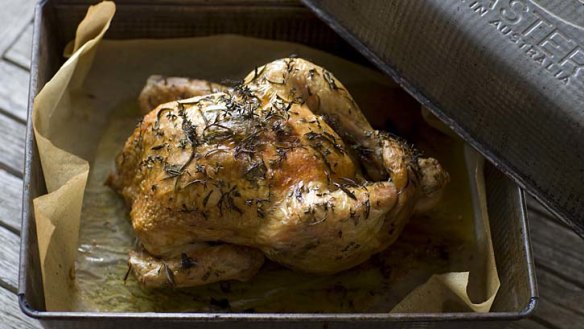How to cook a good roast chook

A good roast chook is a staple in any home cook's repertoire. But how do you do it? And how do you make sure the roast vegies with it are done just-right? Cookbook author Belinda Jeffery shares her tips and a foolproof recipe.
Equipment
There are no fancy kitchen gadgets required for roasting a chicken. The most you need is a solid roasting pan – Belinda Jeffery uses a strong stainless steel one – some kitchen twine to loosely tie the legs together, a wooden spoon to beat the butter, and paper towel to pat the chicken dry (this will allow the skin become crisp).
Golden, crispy skin
The better the quality of chicken used, the better it will taste. Try to buy organic, free range chicken (and save the carcass afterwards to make chicken stock!) Ensure you pat the skin dry with paper towel as this helps the skin to crisp up nicely. Putting the butter under the skin helps to moisten the breast meat, which is the leanest part of the chicken, and also allows the beautiful flavour of the herbs to permeate the meat, which won't do as well if the butter is rubbed only on the outside of the chicken. Lemon juice over the top also helps the skin crisp up.
Trussing and stuffing
It's up to the individual whether to stuff or baste the chicken – Jeffery skips both for this recipe and finds the herbs, lemon and butter do more than enough to flavour the chicken. Take your time when loosening the chicken skin as the recipe asks but if it does get pierced just try to close it over as best you can. You can even use a bit of the loose neck skin to patch it if necessary. Don't fuss too much over the recipe, tarragon works well, but feel free to use whatever herbs are available.
Crisp vegetables
To get nicely crisp roast vegies, cook them in a separate pan so they don't get soggy from the chicken juices. The chook also gives off moisture while it's in the oven, so the vegies will crisp up even more if you leave them in the oven once you've removed and are resting the meat. It helps to par-cook potatoes before putting them in the oven – Jeffery steams them until nearly done, then roughs them up a bit and tosses them in olive oil before baking.
Ensuring the chook is cooked
There are a few ways to check that your chook is cooked. One is to wiggle the thigh joints: they should feel slightly loose and move fairly freely. Also, any juice coming from the chicken should be clear, not pink (tip some of the juices from the chicken cavity into the pan to check this). Jeffery confesses that she doesn't use a meat thermometer, but says if you have one, insert it into the inner thigh area, between thigh and breast (but not to the bone) and if it registers 74C the chicken is ready.
Belinda Jeffery's roast chicken with herbs
140g unsalted butter, softened
Sea salt, to taste
A bundle of fresh herbs (tarragon, thyme, rosemary and sage all work really well) – aim for 2 - 3 tablespoons of chopped herbs, with some leftover to scatter on top
1.8 - 2kg organic (or free-range) chicken
1 lemon, halved
Method
Preheat your oven to 230C.
Put the butter and sea salt into a bowl. Use a wooden spoon to thoroughly beat them together and lighten the butter a little. Add 2 - 3 tablespoons chopped herbs to the butter and mix everything together.
Pat the chicken dry and then carefully slide your fingers between the skin and the flesh at the neck end. Gently loosen the skin all over the breast, thighs and drumsticks.
Now scoop up some of the herb butter in your fingers (you may like to wear prep gloves to do this) and spread it onto the flesh under the skin you have loosened. It's a bit awkward to do, but you soon get the hang of it. Do this all over the chook reserving any leftover butter. When that's done, sit the chicken in a roasting tin (lining it with baking paper isn't necessary but can reduce clean-up time!).
Loosely tie the drumsticks together at their base with a bit of kitchen twine and tuck the wingtips under the neck. Once you've done this, spread any remaining butter over the outside of the chicken then pick off leaves or tiny sprigs from the leftover herbs and scatter these all over the top. Squeeze on the juice from the lemon then tuck the lemon halves and any leftover herbs into the cavity.
Sit the tin in the oven and roast the chicken for 20 minutes, then reduce the heat to 205C and continue to cook it for another 50 minutes. You may baste it every now and then if you remember, but if you just leave it be, you'll still end up with a very delicious chicken.
When it's ready – and it will look and smell divine at this stage – remove the chicken from the oven. Leave it to settle in a warm spot for at least 15 minutes before carving it. While it's settling, tip the herby, lemony juices left in the roasting pan into a jug and let them sit for a bit, then spoon the fat off the top. Serve the juices with the chicken.
It looks beautiful served whole on a big platter with fresh herb sprigs tucked around it.
Serves 4
Belinda Jeffery's cookbooks include Mix & Bake and The Country Cookbook (where the original version of this recipe appeared). Her next book, Utterly Delicious Simple Food is due out September through Lantern.
Appears in these collections
The best recipes from Australia's leading chefs straight to your inbox.
Sign up